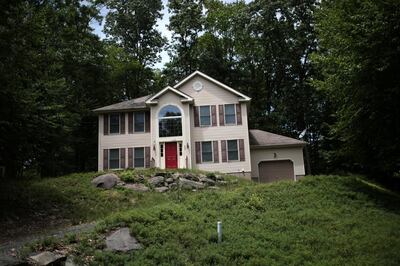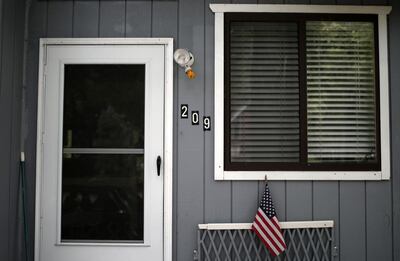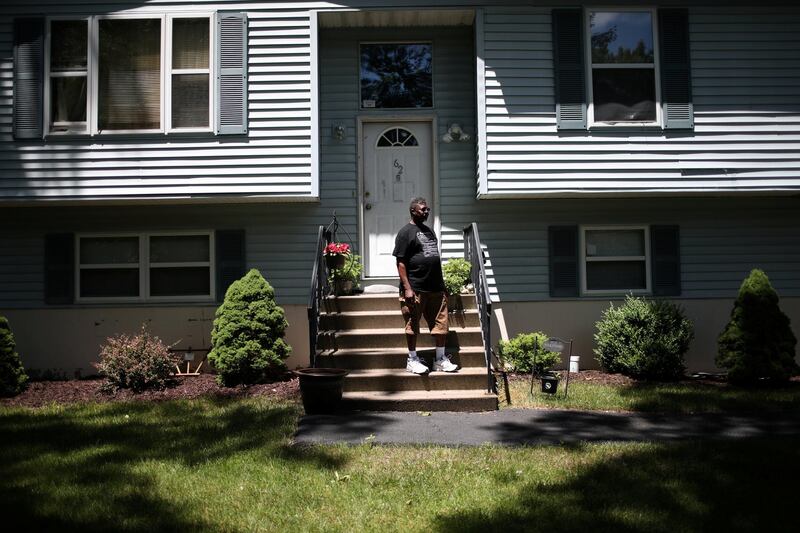School bus driver Michael Payne was renting an apartment on the 30th floor of a New York City high-rise, where the landlord's idea of fixing broken windows was to cover them with boards.
So when Mr Payne and his wife Gail saw ads in the tabloids for brand-new houses in the Pennsylvania mountains for under $200,000, they saw an escape. The middle-aged couple took out a mortgage on a $168,000, four-bedroom home in a gated community with swimming pools, tennis courts and a clubhouse.
“It was going for the American Dream,” Mr Payne, now 61, says. “We felt rich.”
Today the powder-blue split-level is worth less than half of what they paid for it 12 years ago at the peak of the nation’s housing bubble.
Located about 128 kilometres northwest of New York City in Monroe County, Pennsylvania, their home resides in one of the sickest real estate markets in the United States, according to a Reuters analysis. More than one-quarter of homeowners in Monroe County are deeply “underwater,” meaning they still owe more to their lenders than their houses are worth.
The world has moved on from the global financial crisis. Hard-hit areas such as Las Vegas and the Rust Belt cities of Pittsburgh and Cleveland have seen their fortunes improve.
But the Paynes and about 5.1 million other US homeowners are still living with the fallout from the real estate bust that triggered the epic downturn.
As of June 30, nearly one in 10 American homes with mortgages were “seriously” underwater, according to Irvine, California-based Attom Data Solutions, meaning that their market values were at least 25 per cent lower than the balance remaining on their mortgages.

It is an improvement from 2012, when average prices hit bottom and properties with severe negative equity topped out at 29 per cent, or 12.8 million homes. Still, it is double the rate considered healthy by real estate analysts.
"These are the housing markets that the recovery forgot," says Daren Blomquist, a senior vice president at Attom.
Lingering pain from the crash is deep. But it has fallen disproportionately on commuter towns and distant exurbs in the eastern half of the United States, Reuters analysis found. Among the hardest hit are bedroom communities in the Midwest, mid-Atlantic and Southeast regions, where income and job growth have been weaker than the national norm.
_________
Read more:
[ Are we ready to handle the next financial crisis? ]
Scandinavians struggle with their debt burden
New online calculator helps Dubai residents decide to rent or buy
__________
Developments in outlying communities typically suffer in downturns. But a comeback has been harder this time around, analysts say, because the home-price run-ups were so extreme, and the economies of many of these Midwestern and Eastern metro areas have lagged those of more vibrant areas of the country.
“The markets that came roaring back are the coastal markets,” says Mark Zandi, chief economist at Moody’s Analytics. He said land restrictions and sales to international buyers have helped buoy demand in those areas. “In the middle of the country, you have more flat-lined economies. There’s no supply constraints. All of these things have weighed on prices.”

In addition to exurbs, military communities showed high concentrations of underwater homes, the analysis showed. Five of the Top 10 underwater counties are near military bases and boast large populations of active-duty soldiers and veterans.
Many of these families obtained financing through the US Department of Veterans Affairs. The VA makes it easy for service members to qualify for mortgages, but goes to great lengths to prevent defaults. It is a big reason many military borrowers have held on to their negative-equity homes even as millions of civilians walked away.
A poor credit history can threaten a soldier's security clearance. And those who default risk never getting another VA loan, says Jackie Haliburton, a Veterans Service Officer in Hoke County, North Carolina. “You will keep paying, no matter what, because you want to make sure you can hang on to that benefit."
These and other casualties of the real estate meltdown are easy to overlook as homes in much of the country are again fetching record prices.
But in Underwater America, homeowners face painful choices. To sell at current prices would mean accepting huge losses and laying out cash to pay off mortgage debt. Leasing these properties often won’t cover the owners’ monthly costs. Those who default will trash their credit scores for years to come.
________
Read more:
[ Nine lessons from the global financial crisis ]
UAE residents track finances better but struggle with saving and debt
Pre-crisis mortgages linger for big US banks and homeowners
_________
Special education teacher Gail Payne noses her Toyota Rav 4 out of the driveway most workdays by 5 am for the two-hour ride to her job in New York City's Bronx borough.
“I hate the commute, I really, really do," Ms Payne says. "I’m tired.”
Now 66, she and husband Michael were counting on equity from the sale of their house to fund their retirement in Florida. For now, that remains a dream.
The Paynes’ gated community of Penn Estates, in East Stroudsburg, Pennsylvania, is among scores that sprang up in Monroe County during the housing boom.
Prices looked appealing to city dwellers suffering from urban sticker shock. But newcomers didn’t grasp how irrational things had become: At the peak, prices on some homes ballooned by more than 25 percent within months.
Today, homes that once fetched north of $300,000 now sell for as little as $72,000. But even at those prices, empty houses languish on the market. When the easy credit vanished, so did a huge pool of potential buyers.
_________
Read more:
[ Are these the warning signs of an approaching global recession? ]
Should UAE residents focus on retirement or paying down their mortgage?
Getting on the property ladder a tight squeeze for Hong Kong's young professionals
__________
How easy is it to secure a mortgage now?
Today, getting a mortgage is tougher - and less risky. For one thing, no-money-down mortgages and their ilk, which enabled many borrowers to initially lower the costs of buying a home but often saddled borrowers with far higher balances or steep monthly payment increases, have vanished.
Banks also remain a bit wary after racking up billions in losses stemming from mortgages gone bad. That means homebuyers, especially those with less-than-stellar credit, face more hurdles qualifying for a mortgage than they did in the housing boom years. But the loans are safer, more transparent and actually take into account whether a borrower can afford to keep up with payments.
"The banks have certainly loosened underwriting criteria for low-risk borrowers; they haven't loosened underwriting criteria for low-credit score borrowers," says Aaron Terrazas, senior economist at Zillow. "The types of lending that we saw leading up to that crash in 2008, for the most part, we're not seeing nowadays."
Legislation aimed at averting another financial crisis set out certain guidelines that lenders must follow if they want to make their home loans eligible to be guaranteed by the government. The biggest change is a rule requiring lenders to establish the borrower's ability to repay the loan.
The guidelines may offer lenders a clear path on how to gauge qualified buyers, but in many cases banks have overlaid stricter qualifying requirements, like higher credit scores.
That's one reason the average FICO score on home purchase loans has drifted about 21 points higher over the past decade, according to data from the Urban Institute. The average FICO score in America was 700 last year. A score of 740-799 is considered "very good."
"The pendulum has swung too far in the other direction," says Jesse Van Tol, chief executive of the National Community Reinvestment Coalition, which advocates for fairness in housing, banking and business.. "When you look at a Fannie Mae or Freddie Mac-backed loan with an average credit score in the high 700s, homeownership at a 50-year low, and a lot of people boxed out of the mortgage market, certainly credit is too tight. Too few people have the opportunity to become homeowners today."






